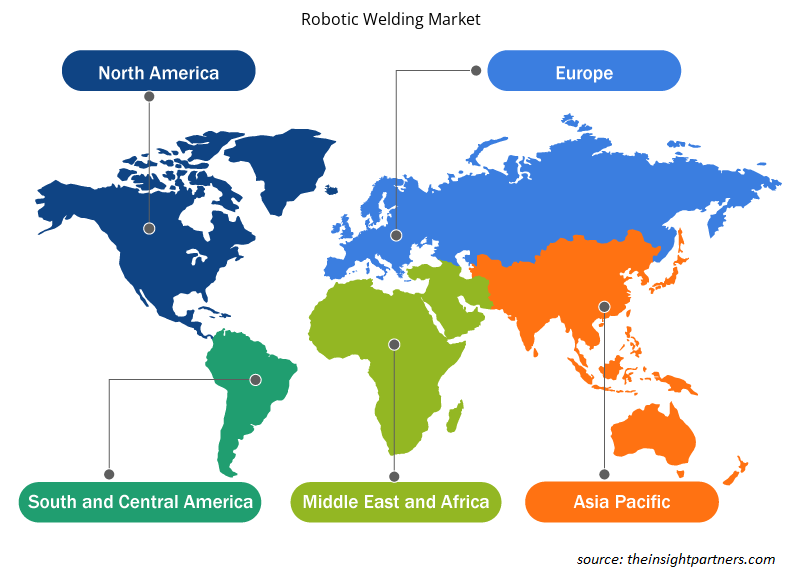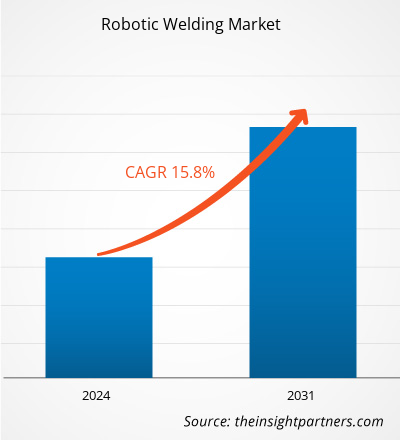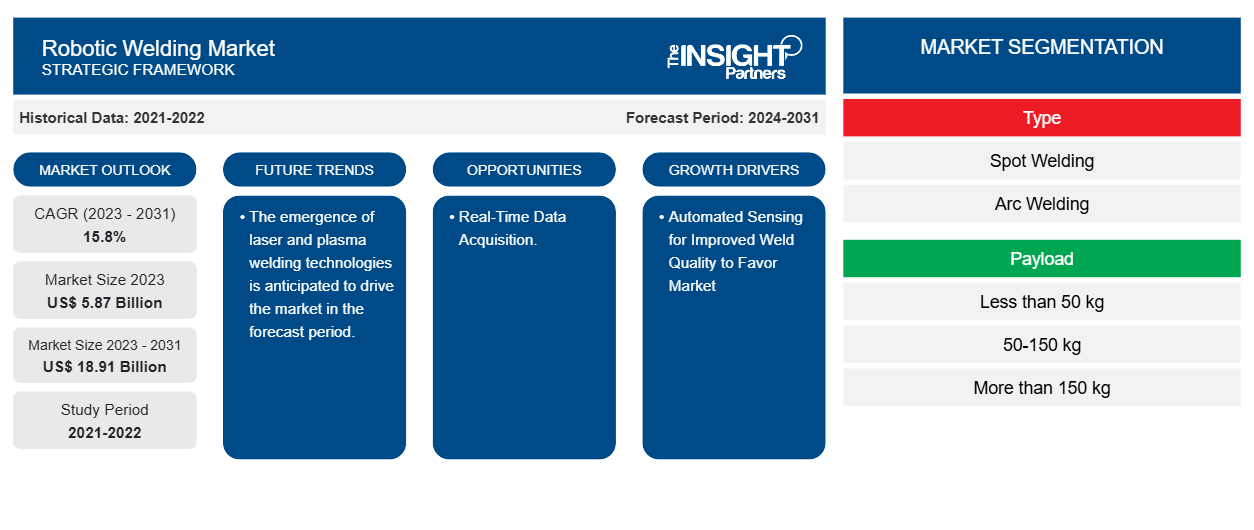로봇 용접 시장 규모는 2023년 58억 7천만 달러에서 2031년까지 189억 1천만 달러에 이를 것으로 예상됩니다. 이 시장은 2023~2031년 동안 15.8%의 CAGR을 기록할 것으로 예상됩니다. 산업용 로봇에 대한 수요를 견인하는 산업 4.0과 자동차 산업에서 용접 로봇 채택 증가가 시장의 주요 동인이자 추세가 될 가능성이 높습니다.
로봇 용접 시장 분석
로봇 용접 시장은 전 세계적으로 상당한 성장을 경험하고 있습니다. 이러한 성장은 산업용 로봇에 대한 수요를 촉진하는 산업 4.0과 자동차 산업에서 용접 로봇의 채택 증가에 기인합니다. 또한 APAC에서 디지털 전환을 지원하기 위한 정부 이니셔티브와 레이저 및 플라즈마 용접 기술의 등장은 로봇 용접 시장의 성장을 뒷받침하는 다른 요인 중 하나입니다.
로봇 용접 시장 개요
로봇 용접은 산업 부문이 프로세스를 자동화하고, 정확도를 높이고, 리드 타임을 줄이고, 안전을 강화하는 데 도움이 되는 방법입니다. 로봇 용접 프로세스는 대량 및 반복 작업에 구현될 때 가장 생산적인 것으로 간주됩니다. 로봇 용접 프로세스에는 여러 유형이 있습니다.
귀하의 요구 사항에 맞게 이 보고서를 사용자 정의하세요
이 보고서의 일부 또는 국가 수준 분석, Excel 데이터 팩을 포함하여 모든 보고서에 대한 사용자 정의를 무료로 받을 수 있으며 신생 기업 및 대학을 위한 훌륭한 혜택과 할인 혜택을 이용할 수 있습니다.
-
이 보고서의 주요 시장 동향을 알아보세요.이 무료 샘플에는 시장 동향부터 추정 및 예측까지 다양한 데이터 분석이 포함됩니다.
로봇 용접 시장 동인 및 기회
개선된 용접 품질을 위한 자동 감지로 시장 선호
자동화된 감지 기술을 통해 로봇 용접공은 개별 작업물 치수에 따라 작업을 채택할 수 있습니다. 이를 통해 각 용접의 품질이 향상되고 작업 속도가 빨라지며 결과적으로 처리량이 높아집니다. 각 용접 셀에 이러한 기술을 포함하면 용접 작업을 모니터링하고 지속적인 프로세스 최적화를 위해 세부 정보를 기록하고, 작업물에 따라 용접 로봇의 매개변수를 자동으로 조정하고 용접 작업을 모니터링하고 지속적인 프로세스 최적화를 위해 세부 정보를 기록하는 데 도움이 됩니다.
실시간 데이터 수집
자동화된 감지와 함께 로봇 용접 시스템의 운영 데이터 수집 및 분석이 빠른 속도로 발전하고 있습니다. 각 용접은 품질 관리 프로세스를 검증하기 위해 특정 검사가 필요하므로 이러한 도구를 사용하면 용접 작업 중에 조인트 강도, 모든 이음매의 밀봉 및 용접 침투를 입증할 수 있습니다.
아크 추적 제어 시스템은 결함을 자동으로 식별하고 용접 작업을 수정하여 일반적으로 2차 검사 중에만 표면화되는 재작업을 최소화할 수 있습니다. 또한 이러한 시스템은 용접 작업 중 조인트 폭 및 프로파일 측정, 조인트 가장자리 감지, 용접 중 솔기 관통 추적을 제공하여 사양에 따라 용접 관통을 제어합니다.
로봇 용접 시장 보고서 세분화 분석
로봇 용접 시장 분석에 기여한 주요 세그먼트는 유형, 탑재량, 최종 사용자입니다.
- 유형에 따라 로봇 용접 시장은 스팟 용접, 아크 용접 및 기타로 구분됩니다. 전력 관리 구성 요소 세그먼트는 예측 기간 동안 상당한 시장 점유율을 차지할 것으로 예상됩니다.
- 탑재량 기준으로 로봇 용접 시장은 50kg 미만, 50-150kg, 150kg 초과로 구분됩니다. 50kg 미만 세그먼트는 예측 기간 동안 상당한 시장 점유율을 차지할 것으로 예상됩니다.
- 최종 사용자별로 시장은 자동차 및 운송, 전기 및 전자, 금속 및 기계, 건설로 세분화됩니다. 자동차 및 운송은 예측 기간 동안 상당한 시장 점유율을 차지할 것으로 예상됩니다.
지역별 로봇 용접 시장 점유율 분석
로봇 용접 시장 보고서의 지리적 범위는 주로 북미, 아시아 태평양, 유럽, 중동 및 아프리카, 남미 및 중부 아메리카의 5개 지역으로 나뉩니다.
북미는 로봇 용접 시장을 지배해 왔습니다. 북미 지역의 다양한 산업에서 첨단 기술 도입 추세가 로봇 용접 시장의 성장을 촉진했습니다. 디지털 도구 도입 증가와 정부 기관의 첨단 기술 지출과 같은 요인이 북미 로봇 용접 시장 성장을 견인할 것으로 예상됩니다. 게다가 미국과 캐나다의 선진 경제에서 연구 개발에 중점을 두면서 북미 업체는 기술적으로 진보된 솔루션을 시장에 내놓을 수밖에 없습니다. 게다가 미국에는 혁신적인 솔루션 개발에 점점 더 주력하고 있는 로봇 용접 시장 업체가 많이 있습니다. 이러한 모든 요인이 이 지역의 로봇 용접 시장 성장에 기여합니다.
로봇 용접 시장 지역 통찰력
Insight Partners의 분석가들은 예측 기간 동안 로봇 용접 시장에 영향을 미치는 지역적 추세와 요인을 철저히 설명했습니다. 이 섹션에서는 북미, 유럽, 아시아 태평양, 중동 및 아프리카, 남미 및 중미의 로봇 용접 시장 세그먼트와 지리에 대해서도 설명합니다.

- 로봇 용접 시장에 대한 지역별 특정 데이터 얻기
로봇 용접 시장 보고서 범위
| 보고서 속성 | 세부 |
|---|---|
| 2023년 시장 규모 | 58억 7천만 달러 |
| 2031년까지 시장 규모 | 189억 1천만 달러 |
| 글로벌 CAGR (2023-2031) | 15.8% |
| 역사적 데이터 | 2021-2022 |
| 예측 기간 | 2024-2031 |
| 다루는 세그먼트 |
유형별로
|
| 포함된 지역 및 국가 |
북아메리카
|
| 시장 선도 기업 및 주요 회사 프로필 |
|
로봇 용접 시장 참여자 밀도: 비즈니스 역학에 미치는 영향 이해
로봇 용접 시장은 소비자 선호도의 변화, 기술 발전, 제품의 이점에 대한 인식 증가와 같은 요인으로 인해 최종 사용자 수요가 증가함에 따라 빠르게 성장하고 있습니다. 수요가 증가함에 따라 기업은 제품을 확장하고, 소비자의 요구를 충족하기 위해 혁신하고, 새로운 트렌드를 활용하여 시장 성장을 더욱 촉진하고 있습니다.
시장 참여자 밀도는 특정 시장이나 산업 내에서 운영되는 회사나 기업의 분포를 말합니다. 주어진 시장 공간에 얼마나 많은 경쟁자(시장 참여자)가 존재하는지 그 규모나 전체 시장 가치에 비해 나타냅니다.
로봇 용접 시장에서 운영되는 주요 회사는 다음과 같습니다.
- 파나소닉 주식회사
- 야스카와 전기 주식회사
- 씨줄
- 파누크 주식회사
- IGM 로봇 시스템
- 가와사키 중공업 주식회사
면책 조항 : 위에 나열된 회사는 어떤 특별한 순서에 따라 순위가 매겨지지 않았습니다.

- 로봇 용접 시장의 주요 기업 개요를 알아보세요
로봇 용접 시장 뉴스 및 최근 개발
로봇 용접 시장은 1차 및 2차 연구 이후의 정성적, 정량적 데이터를 수집하여 평가합니다. 여기에는 중요한 기업 간행물, 협회 데이터 및 데이터베이스가 포함됩니다. 로봇 용접 시장의 몇 가지 개발 사항은 다음과 같습니다.
- Kemppi에서 새로운 로봇 용접기인 AX MIG Welder를 출시했습니다. Kemppi AX MIG Welder를 소개합니다. 완벽한 통합, 사용하기 쉬운 인터페이스, 최신 용접 기술을 갖춘 강력한 로봇 용접기입니다. AX MIG Welder는 고강도, 24/7 자동 용접 환경을 위해 특별히 제작되었습니다. 400 또는 500A 전력과 로봇 와이어 공급기를 탑재하여 어려운 작업을 수행하고 까다로운 생산 목표를 충족하도록 설계되었습니다. (출처: Kemppi 회사 웹사이트, 2023년 4월)
- 미국 최대의 여성 전용 용접 와이어 브랜드인 NS ARC와 100년 이상의 업계 경력을 가진 로봇 용접 기술의 선구자인 CLOOS North America가 전략적 제휴를 자랑스럽게 발표합니다. (출처: NS ARC 회사 웹사이트, 2024년 7월)
로봇 용접 시장 보고서 범위 및 제공물
"로봇 용접 시장 규모 및 예측(2021-2031)" 보고서는 아래 영역을 포괄하는 시장에 대한 자세한 분석을 제공합니다.
- 범위에 포함된 모든 주요 시장 부문에 대한 글로벌, 지역 및 국가 수준의 로봇 용접 시장 규모와 예측입니다.
- 로봇 용접 시장 동향과 드라이버, 제약, 주요 기회와 같은 시장 역학에 대한 정보입니다.
- PEST/포터의 5가지 힘과 SWOT 분석이 자세히 나와 있습니다.
- 주요 시장 동향, 글로벌 및 지역 프레임워크, 주요 업체, 규정, 최근 시장 개발 등을 다루는 로봇 용접 시장 분석입니다.
- 시장 집중도, 히트맵 분석, 주요 업체, 로봇 용접 시장의 최근 동향 등을 다루는 산업 환경 및 경쟁 분석입니다.
- 자세한 회사 프로필
- 과거 분석(2년), 기준 연도, CAGR을 포함한 예측(7년)
- PEST 및 SWOT 분석
- 시장 규모 가치/거래량 - 글로벌, 지역, 국가
- 산업 및 경쟁 환경
- Excel 데이터세트
최근 보고서
사용 후기
구매 이유
- 정보에 기반한 의사 결정
- 시장 역학 이해
- 경쟁 분석
- 고객 인사이트
- 시장 예측
- 위험 완화
- 전략 기획
- 투자 타당성 분석
- 신흥 시장 파악
- 마케팅 전략 강화
- 운영 효율성 향상
- 규제 동향에 발맞춰 대응























 무료 샘플 받기 - 로봇 용접 시장
무료 샘플 받기 - 로봇 용접 시장